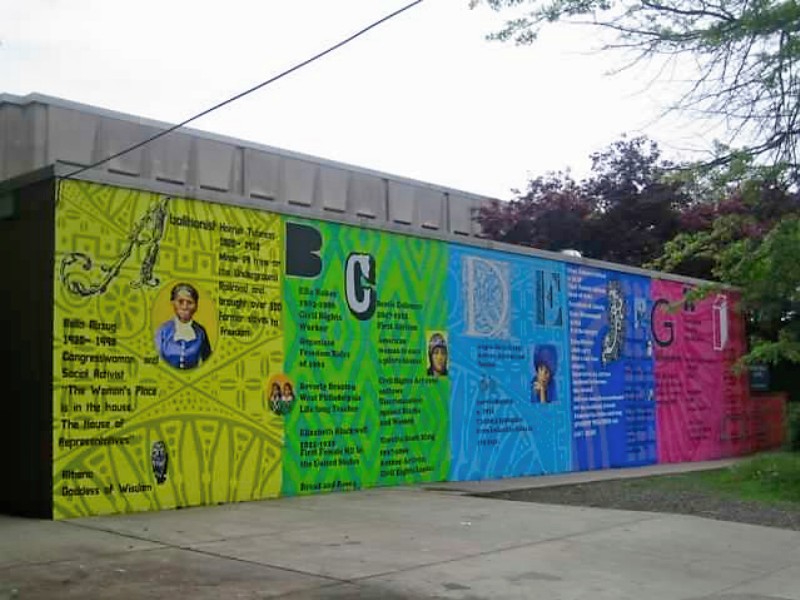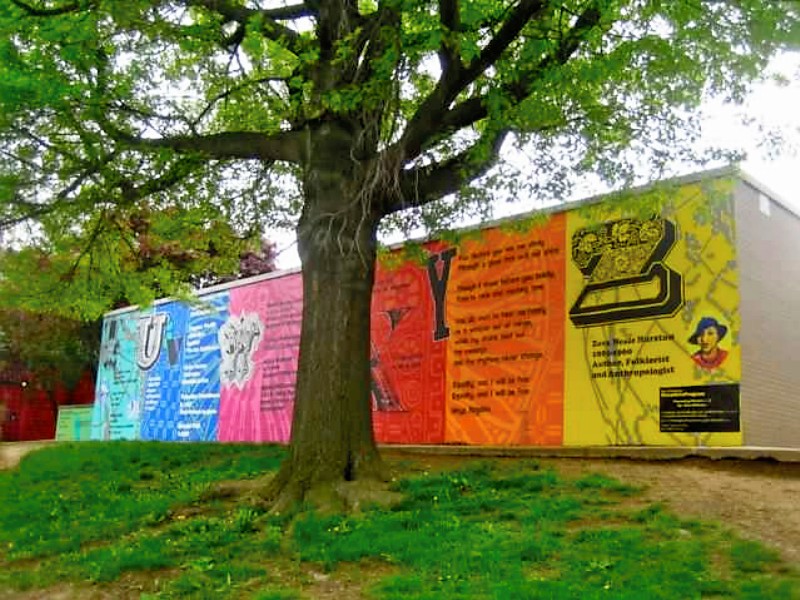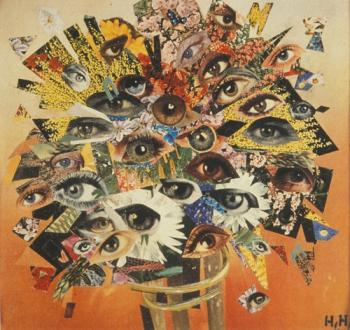Serendip is an independent site partnering with faculty at multiple colleges and universities around the world. Happy exploring!
Walled Women



POST YOUR THOUGHTS HERE
Welcome to the on-line conversation for Women in Walled Communities, a cluster of three courses in a new 360° @ Bryn Mawr College that focuses on the constraints and agency of individual actors in the institutional settings of women's colleges and prisons.
This is an interestingly different kind of place for writing, and may take some getting used to. The first thing to keep in mind is that it's not a site for "formal writing" or "finished thoughts." It's a place for thoughts-in-progress, for what you're thinking (whether you know it or not) on your way to what you think next. Imagine that you're just talking to some people you've met. This is a "conversation" place, a place to find out what you're thinking yourself, and what other people are thinking. The idea here is that your "thoughts in progress" can help others with their thinking, and theirs can help you with yours.
Who are you writing for? Primarily for yourself, and for others in our cluster. But also for the world. This is a "public" forum, so people anywhere on the web might look in. You're writing for yourself, for others in the class, AND for others you might or might not know. So, your thoughts in progress can contribute to the thoughts in progress of LOTS of people. The web is giving increasing reality to the idea that there can actually evolve a world community, and you're part of helping to bring that about. We're glad to have you along, and hope you come to both enjoy and value our shared explorations. Feel free to comment on any post below, or to POST YOUR THOUGHTS HERE.

Active and Passive Voices
When I started reading "A Journey into Speech," I was immediately struck by the way Cliff had to overcome a silencing of her culture – the African roots of Jamaica – in order to be able to accurately speak to herself. I was also struck by the way she had to bridge the gap between King's English and patois that was created by this silencing. For Cliff, words take on the role of tools to funnel her frustration and rage. She writes to expose the influence of the colonizerand in this exposure, she finds a voice that is separate from either King's English or patois. This new voice, though fragmented, is her way of showing the struggle of Jamaicans and other colonists to understand their dual identities – the mother country versus the colony.
In contrast, Smith sees words as the end rather than the tool. In the introduction to "Fires in the Mirror," Smith describes her relationship with words as follows: "I had not controlled the words. I had presented myself as an empty vessel, a repeater, and they had shown their power." Unlike Cliff, whose words were difficult to find and difficult to fit together because of her fragmented history, Smith acts as a more passive writer. She uses language as a tool for learning too, but she doesn't so actively use it as a tool for change. In fact, she's not even chanelling her own feeling or emotion, but others' feelings and emotions.

Silence and Perspective


Silence and Motion
When I thought about silence, I kept coming back to what Irene said in class about silence being entangled with noise; such as our pauses between words and sentences. So I felt as though my visualization needed to convey my fascination with the concept of silence as a part of a larger whole that incorporates both silence and noise. I envisioned silence just before or after something completes a fall, the silence of the fall itself. This idea felt similar to the phrase “the quiet before the storm.” For me, this “quietness” or silence before noise was captured through a photograph of a raindrop as it rolls off the tip of a leaf. Ultimately the drop will break its fall to create both sound and movement but the moments before that plop into the water and subsequent ripple effect seem silent to me. This is especially true in photographs, which can capture moments and extend them, making them appear clear and motionless. The capture itself is a kind of silencing, because whatever was in motion will stay forever poised, locked in the silence occurring before the drop. A person who looks at a photograph sees the frozen moment and anything else they see or hear is imagined and shaped by their own interpretation and expectations of that moment.

Experiencing silence
To reach the state of absolute silence is hard. The reason I choose this picture is to represent the place where I think I might find certain level of silence. Every object, whether it's living or not, has its own way of exsiting in this world and makes its sound in its own frequency. The world we are living is composed of the music made by all objects around us. Their existences don't depend on our achknowledgement. However, it is said that once you reach the deeper depth of sea, you will experience deadly silence. I still doubt whether it's absolute silence. If we can't hear it, does it mean that the silence finally takes place.


Language
At the beginning of her essay Anna Devere Smith explains that when she started her project she was “not as interested in performance” as she was in language. This immediately struck me because I’ve always considered speech and the use of language to be a type of performance in and of itself. Language goes beyond words – we express ourselves through intonation, body movement, pitch, and facial expression. We are always theatrical when we talk. We are performing. The dichotomy Smith initially presents between the actor and the character is therefore confusing to me because I really do think that we are all playacting ourselves in everyday life. She goes on to explain that “the act of speech, then, does become performance” in reference to seasoned interview subjects who spit out sound bites with ease. But we’re all acting all the time, and the types of criticism Smith encountered during her performances of “On the Road” are censures that most people have encountered at sometime in our life. We are all characters of ourselves which is why its possible for everyday people to be “not black enough” or “too Jewish” in our speech and affectation even when we’re not standing on a stage.

Sept 5th, 2012 S1: Picture
The image is my bedroom. I chose this photo because it's intuitively devoid of sound because it's devoid of people. Even to me, someone who talks in there incessantly, knows that the sound of the upstair's cat's footsteps are thumpering from the ceiling, and just knows this space intimately. It's always interesting how we tend to associate sounds with people--especially in more man-made constructions and constructs.
In regards to yesterday's conversation, I find more solace and comfort in silence. This picture of my bedroom makes me wish I was home and alone.

Sept 5th, 2012 P1: Question on "character"
Smith makes mention of the concept of a "Character" two times within her introduction. One time where she says 'The process of getting to that poetic moment is where "character" lives....Character lives in the linguistic road as well as the destination." (pg. xxxvi), and again on pg. xxxvii where she says, "Mimicry is not character. Character lives in the obvious gap between the real person and my attempt to seem like them..." The question on my mind is what is meant exactly by "character" in Smith's essay, and what it also means in our own daily lives. Is character merely fictitous or based in performances? Can we actually live a life as a character?

Writing About Speech
Though Anna Deavere Smith raises many interesting points, I couldn't reconcile myself with her simultaneous celebration of the beauty in imperfect language and the poetic, sometimes over-written words I held in my hands. I think the greatest issue was, as she admits, trying to explain a piece that is about dialogue on the silent, static, monochromatic world of the page. I don't know if I'm reading too much, some pun intended, into her introduction, but the dissonance bothers me. Her descriptions of the interviews and audience's reactions to her play don't make me feel anything. And maybe this proves her point about the transformative nature not of words themselves but of what happens when words are spoken.
Despite this struggle with her words, I did find much of Smith's piece thought-provoking, particularly her exploration of the hesitation to mimic actually serving as an insult. She raises many interesting questions, many more than would be productive to share in this space. If I ignore your difference, do I ignore you? If I fail to speak about how I see and hear you, or if I sanitize my speech in efforts to be 'politically correct,' am I effectively transforming you into me? Is this a form of verbal genocide--the murder of the language of an oppressed group? And, if I fail to speak about my own experience, am I truly myself?

Seeing Silence
 To depict a visualization of silence, I chose Hannah Hoch's Bouquet of Eyes. It is a work that uses disparate elements to create something unsettling but also beautiful. Like Hoch's work, silence is a powerfully affective experience that causes a distinct response in each individual. It strengthens one or multiple senses, in many cases vision, but does not merely use the eye as a window through which to look but also often puts the self in the position of the object, giving time for self-reflection. It is isolating, unifying, and can appear like one thing while simultaneously being something wholly different.
To depict a visualization of silence, I chose Hannah Hoch's Bouquet of Eyes. It is a work that uses disparate elements to create something unsettling but also beautiful. Like Hoch's work, silence is a powerfully affective experience that causes a distinct response in each individual. It strengthens one or multiple senses, in many cases vision, but does not merely use the eye as a window through which to look but also often puts the self in the position of the object, giving time for self-reflection. It is isolating, unifying, and can appear like one thing while simultaneously being something wholly different.

Reactions to Cliff
After reading Cliff, I've noticed that she places much emphasis on projecting anger outwards rather than inwards as way to deal with oppression. She claims that she used the piece "If I could Write this in Fire I would Write this in Fire" to express her anger at her experience as a member of a colonized country. This has made me think about the power of words, and the prisons these "voices" can become, even when we see them as therapeutic. As I struggle with my identity as an immigrant, a woman of color, a latina, and a woman anger has been an option too many times but so has silence. So what is the best way to deal with the effects that all of the "-isms" have on us? I have used silence, and failed. As I swallowed my words I became angrier at my inability to point out statements or actions that I felt were hurtful to my community and myself. Silence, was what I was taught was the best way to handle these things in America, as my mother and father repeatedly brushed off blatantly disrespectful situations. I have also chosen anger. After coming to Bryn Mawr, I began being loud. I pointed out and sought situations that would allow me to "educate" those who spoke ignorant comments but that was exhausting. In both voice and silence I found myself unhappy when dealing with these "isms." I wonder how the author felt after releasing all of the anger, and how others deal with issues as deep as colonialism, racism, and sexism.

Silence as Snow
As a city girl, I'm used to constant noise. Silence, then, is something that doesn't necessarily mean an absense of noise. Silence can simply be an opportunity to pause. The image I picked comes from the album artwork for a band called Sleeping At Last. The snow reminds me of the quietest times in the city. The snow muffles sounds and hangs in the air, while city dwellers stay inside – out of sight and sound. Not only is the city audibly quieter, but – if there's enough snow – there is also a pause in activity. Students stay home from school, cars and trucks stop their deliveries of people and cargo, and shops close for the afternoon. Snowy days in the city are the only days I see people stop walking to look up and around. Something about snow encourages people to focus on something outside of themselves.

In the Midst of Violence and Poverty: Silence
Benjamin Franklin Senior High is an image that emphasizes silence for me. As I sat by my computer looking through the photos I had taken this summer, I came across some of my old high school. I had taken these pictures on an evening out with my mother because I thought the campus looked so beautiful. I neglected to see however, how much of the beauty I saw was due to the silence of no students walking around. When I was a student here I remember always feeling like the students' lack of interest in the school or in academia itself made way for trivial conversations and relationship that cluttered the halls of the school with noise- trivial noise. Now, as I think back on my thoughts, I realize how much of what I found so trivial was voice in the midst of silence. What I found to be so trivial, because it didn't revolve around academia, the poster board image for change and growth, was in fact a response (possibly a response they were unaware they were sending, but a response nonetheless) to media's constant protrayal of the school as an urban public school in need of assistance. Kids were acting out the very image they were being protrayed as: bad kids who are uninterested in education. Althougth I don't know whether this voice was a voice of choice or whether it was a voice that was imposed on the students, I wonder whether either voice is being heard, or whether it remains silent?


Silence in Sleep
Today when we were sharing our observations of silence, I noticed that many of us brought up this routine of stressing ourselves out right before we sleep at night. I'm guilty as well! Even when I actively search for silence, my thoughts don't stop and all of a sudden it gets really loud in my mind. It was frustrating that I couldn't be silent in my mind. I thought silence would be easy to come by but it's not. Although I did think of a moment of when there's absolute silence... when I'm asleep! My mind eventually stops racing with thoughts and I can finally fall asleep. I don't think any kind of sleep means there's silence - it's the dreamless nights of sleep I'm specifically thinking of. I'd like to think that while I sleep at night, there is some form of silence that I can acheive.

Silence Image: Hiking Abroad
This is a picture I took while I was abroad. It was during our two week travel break. Being abroad in general was a much less stressful environment than being at Bryn Mawr and during travel break, I was generally even more relaxed. I chose this picture because I remember feeling that my mind was very clear and quiet and today in class one of the main themes seemed to be silencing our minds. I kept a blog while abroad and wrote this about the hike: We had the hike first thing after breakfast and I wasn’t super excited, but once we were out in the woods it was a really wonderful and relaxing experience. It reminded me of hikes I’ve been on with my family (with my grandparents in Connecticut and with my dad in brother in New Hampshire). Although I wouldn’t say my mind was completely free of stress ( is it ever? ) I was definitely more relaxed and at peace in the woods than I have been in such a long time…

Thoughts on Fires in the Mirror and A Journey to Speech
In the introduction to Fires in the Mirror, it was hard for me to understand and, from what I did understand, agree with Smith. On page XXIX, she writes, “If only a man can speak for a man, a woman for a woman, a black person for all black people, then, we once again inhibit the spirit of the theater, which lives in the bridge that makes unlikely aspects connected.” I can agree to some extent people with different identities can sympathize, and perhaps even empathize, with each other. However, for instance, in the case of race, I cannot imagine a latino or a white man depicting the character of a black individual and vice versa. Sure, one can depict simple commonalities like hobbies, basic expressions, etc; but a latino/white male will never know how it feels to be black in America and to carry that “burden.” With that said, I don’t think Smith effectively acknowledges how people can overlook huge differences like sex, race, etc to see commonalities. These “isms” are so ingrained in our society that I think they will always be an issue—one that is hard to overlook. Perhaps the “spirit of the theatre” is only doable in theatres but seems highly unlikely in reality.

Deavere Smith/Cliff Readings
When I first started reading the Deavere Smith text, I had to double check to make sure I was reading the right thing. I think I was so hung up on the fact that it's an article pertaining to theater and performances... and I checked out momentarily. What really caught my attention was her observation about the difficulty she had in memorizing a passage: "I had not controlled the words. I had presented myself as an empty vessel, a repeater, and they had shown their power" (XXV). I immediately thought of Paulo Freire and the concept of "banking education" and got really excited that I could tie in something from this course to a previous Education course I had taken! In our Critical Issues class and E-Sem, while I struggled to understand and come to terms with the fact that my all-knowing teachers may have viewed me as an empty vessel waiting to be filled with knowledge, I never dwelled on the idea that I could use my voice to improve my learning experiences as a student. I thought maybe making class a little more interactive could do the trick but I never thought of explicitly using my voice to create change. I can't just expect for my teachers to change things on their own - I have to use my voice to make change because as Deavere Smith's Shakespeare teacher said, speech is an action. Using my voice would be an example of me having the agency to change the way I'm being taught. It seems painfully obvious now that I think of it.
Tension
"I recieved the message of anglocentrism, of white supremacy, and I internalized it. As a writer, as a human being, I have had to accept that reality and deal with its effect on me..."
Cliff
"Does the inability to empathize start with an inhibition or a reluctance to see? Do racism and prejudice instruct those inhibitions?"
"The mirrors of society don't mirror society"
"...tension can be productive in so far as it causes motion, and that we watch and document that motion"
Smith

Thinking about Nature as Silence
This is a illustration I came across while traveling last semester, by two artists named Anders Meisner and Mical Noelson. It's a sort plump, child-like body with straw hands and a straw head. It has neither a mouth nor ears, and therefore has no voice -- a type of artistic scare-crow. Having grown up on a farm in WV, I feel very comfortable and familiar with not speaking or being spoken to for long periods of time, as my experience in such a rural place involved less people and and those people spoke much less often than many of the people I've met at Bryn Mawr and in Philadelphia. I can relate to the straw-headed figure, non-verbal. However, not using verbal communication isn't necessarily silence, although we sometimes consider the pauses in between bits of dialogue to be "awkward silences." Ignoring the myriad of other sounds, the "background noise," only acknowledges human voices as noise and denies all other sounds. Similarly, we are much more inclined to consider the absence of man-made or industrial sounds to be silence, when nature is full of sounds and life. Is this a human-centric, speech-centric view of the audible world? Is it us defining silence only in human terms?
The imagine represents a human quietness which I can relate to and enjoy, but not a silence -- a natural soundscape.


Silence: Its opposite?


It was hard to find a representation of silence. In every google image search, I would find scenic images but then I would think of today's activity and how in the beautiful woods surrounding English house, silence was never void of noise. So, I have decided that the best representation of silence is its opposite: noise. Back home in Boston, silence for young activists is never accepted and was oppressive when enforced upon them. Thus, I have attached two images. Whether it is a small rally about student inequality or a large protest about the future of our nation, perhaps silence is best represented when people use it to make meaning--to add their own original sound to the ever-present soundtrack around them.




